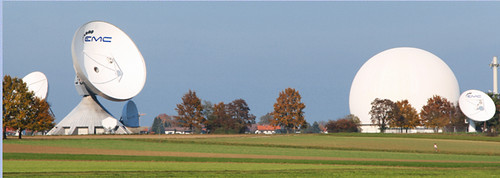Satcom Through-put Breakthrough

Satnews is reporting EMC Satcom was able to fit an STM-1 circuit into a 72-MHz transponder. That’s just awesome…
EMC Satcom Technologies GmbH established a new landmark in satellite link optimization by achieving a symmetrical 155/155Mbps circuit inside a single transponder and, in tur, liberating a full 72MHz transponder. The existing STM-1 in Asia-Pacific was using a 72MHz transponder of the outbound carrier 155Mbps and another 72MHz for the inbound carrier 155Mbps. By placing EMC Satcom’s NRS Bandwidth Booster at each end of the link, a full 72MHz has been cancelled, allowing the existing symmetrical 155/155Mbps STM-1 to operate within one transponder only.
That’s right, it’s patented, too (United States Patent 7,522,877). The abstract…
The reduction of echo noise in satellite communications includes receiving an aggregate signal from multiple remote stations, where the aggregate signal includes a transmit signal, whose bandwidth is in the range of 0.1 MHz to 66 MHz, is previously sent from a hub to the multiple receiving stations, computing a scaled, delayed and distorted replica of the transmit signal and using the replica to compensate for satellite transponder nonlinearities and reduce echo noise interference from a received aggregate signal received by the hub from the multiple remote stations.
And Claim 1…
A method for reducing echo noise in satellite communications in which a hub communicates with multiple remote stations via a satellite having a nonlinear satellite transponder, the method comprising the steps of: transmitting a transmit signal from the hub to the multiple remote stations, where the transmit signal contains at least one carrier; providing, at the hub, a replica of the transmit signal to a buffer that provides an integer sample delay; distorting, at the hub, the replica of the transmit signal according to nonlinearities of the satellite transponder to provide a distorted replica of the transmit signal; determining, at the hub, a scaled, fractional-sample time-delayed, frequency-shifted, and attenuated version of the distorted replica of the transmit signal to provide a compensated distorted replica of the transmit signal; and using, at the hub, the compensated distorted replica to represent the nonlinearities of the satellite transponder and reduce echo noise from a received aggregate signal received by the hub from the multiple remote stations via the satellite transponder; wherein the distorting step further comprises applying a block conversion to the transmit signal to form the distorted replica occupying a predetermined frequency range and the determining step further comprises tracking the integer sample closest to a weight vector centroid of an adaptive filter to provide fractional-sample delay of the distorted replica.
Not something the satellite operators are excited about, as it uses less bandwidth. Further compression is not something they look forward to, hence the interest in 3DTV (and HDTV before that). In this case, the "less bandwidth, more through-put" benefit is for the customer.
The customer is always right.